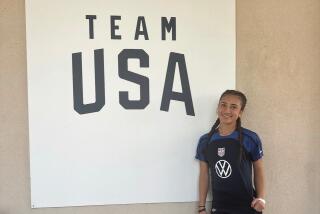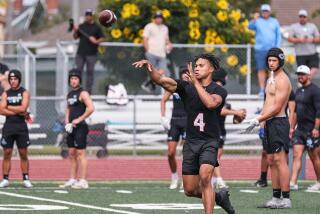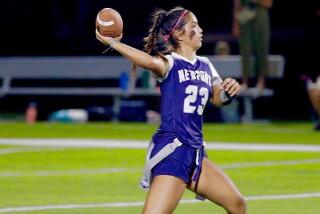SLO in a Fast Lane : Cal Poly Faces Growing Pains as It Tries to Bring Division I Sports to Central Coast
SAN LUIS OBISPO â The new kids on the chopping block live here, playing in a nondescript gymnasium on a sleepy campus nestled among rolling hills and fertile farmland in the shadow of Madonna Mountain.
One preseason poll had the Cal Poly San Luis Obispo Mustangs ranked last among the NCAAâs 302 Division I menâs basketball teams. In another, the Mustangs were No. 301.
Coach Steve Beason expected as much, especially since Cal Poly was 9-16 last season against competition substantially inferior to what it will face in its first season in Division I.
âBeing the one and only new Division I team in the nation, we probably deserve to start at the bottom,â he said.
Just so long as the Mustangs donât stay there.
Cal Poly, a university perhaps best known for its agricultural and high-tech dairy programs, is poised for an ambitious push toward establishing a top-flight athletic program.
Future renovation of the schoolâs 4,000-seat Mott Gym marks only the start of a campaign that Athletic Director John McCutcheon hopes will provide Cal Poly state-of-the-art sports facilities.
Where sheep now graze on grassland adjacent to California 1 heading toward picturesque Morro Bay, McCutcheon envisions a $15-million complex that would include a 15,000-seat football stadium, a 3,000-seat baseball stadium and a 1,000-seat softball stadium.
For now, such facilities are dreams captured only in artistsâ renderings tucked away in McCutcheonâs office. But wheels are in motion. Donations of $225,000 have been solicited to finance feasibility studies, and the tentative construction site has been approved by the schoolâs master planning committee.
Small town. Big plans.
The city of San Luis Obispo, which some folks refer to as âSLO Townâ because of its leisurely pace, has a population of about 45,000. Cal Poly, a scenic expanse of 5,500 acres, has an enrollment of 15,400 students who must occasionally absorb eau de barnyard animal when the wind blows from the south.
However, the school has a sterling academic reputation and an alumni base of about 85,000--mostly in California, and several with deep pockets. Television sportscaster John Madden, a former Mustang player and coach, is an annual contributor to the athletic coffers.
âWe donât have 5,000 people who contribute $1,000 (to athletics) annually,â McCutcheon said. âWhat we do have is a handful of people with very significant resources.â
Cal Poly also has a place in an established conference, giving the Mustangs a leg up on Cal State Northridge and Cal State Sacramento, two other state-system schools that in recent years have tried to boost the level of their athletic programs.
Beginning in the 1996-97 school year, Cal Poly will be a member of the Big West Conference, a model-perfect alliance for the Mustangs both competitively and geographically.
Conversely, Northridge, one of Cal Polyâs former Division II rivals, is in its fifth year in Division I and still has not found a permanent home for its athletic teams.
Northridge has some teams in the fledging, four-member American West Conference; baseball and softball as affiliates in the Western Athletic Conference; menâs volleyball and soccer in the Mountain Pacific Sports Federation and other sports as independents.
For the short term, Cal Poly is in a similar situation with football, cross-country, basketball, track and womenâs tennis teams in the American West; baseball in the WAC; wrestling in the Pacific 10 and soccer, womenâs volleyball, swimming, softball and menâs tennis programs as independents.
Cal Poly would have stumbled had its students not passed a referendum to provide additional funding for athletics in November 1991.
In the biggest turnout in state college history, more than 10,000 Cal Poly students voted on whether to tax themselves on a graduating scale up to $43 a student per quarter to support the schoolâs sports teams.
The proposal, which will add an estimated $2.3 million to the athletic budget next year, passed by 253 votes.
Before the referendumâs passage, Cal Poly coaches were on three-month contracts and the schoolâs 17-sport athletic program was on the brink of being pared to eight. Swimmers were holding themselves out of meets so they could retain an extra year of eligibility should they have to transfer.
âWe had a fish-or-cut-bait situation,â McCutcheon said. âIf the referendum fails, Cal Poly remains Division II--and probably at the lower end of that level.â
A similar referendum recently was narrowly defeated at Northridge, prompting school officials there to consider cutting some athletic programs, football among them.
At Cal Poly, the additional funding covers travel, equipment and some salaries. Athletic scholarships come from ticket revenue, a separate student fee of $4 a student per semester, plus an annual $150,000 donation from a foundation that controls money generated by the universityâs bookstore, food services and dorms.
School officials are relying on alumni and community supporters to provide the funds for improved facilities, thereby completing McCutcheonâs three-tiered recipe for success.
Early indications are encouraging. Beason said that during what he had anticipated would be a quick promotional stop at a local Rotary Club lunch, he was peppered with questions for more than 40 minutes.
Said Chuck Sleeper, Cal Polyâs assistant athletic director in charge of fund raising: âThere are people who ask, âHow do you expect to compete with UCLA and Stanford?â But I run into more people who say, âWhy arenât you?â â
Joining the ranks of those elite schools will take time and plenty of money, even though Cal Poly plans to keep its football team at the Division I-AA level, competing against schools such as Idaho and Montana of the Big Sky Conference.
The best attribute of 8,000-seat Mustang Stadium, home to Cal Polyâs football and soccer teams, is an adjacent grassy area convenient for tailgate parties.
Cal Polyâs baseball team, a Division II finalist in 1993, plays off campus at Sinsheimer Park, a municipal facility on the outskirts of town where umpires must duck inside the press box to change. The Mustangs share the field with San Luis Obispo High and an American Legion team.
Softball is played on campus at a makeshift field surrounded by chicken coops and pastures. Home runs to left field have been known to send feathers flying, and cows have been known to mosey over for a look-see.
Despite that drawback, softball Coach Lisa Boyer successfully recruited Desarie Knipfer of Soquel High in Santa Cruz. She averaged 15.2 strikeouts per seven innings last season, setting a national high school record.
âFacilities are the only piece of the puzzle not in place,â Beason said. âOnce we do that, thereâs no reason we canât compete on a par with everyone in the Big West.â
McCutcheon is confident that the necessary money can be raised, even in these restrictive economic times.
âPeople donât give to a debt, but theyâll give to a dream,â he said. âItâs like investing in stock.â
Just donât expect to see Cal Polyâs marquee investment, its menâs basketball program, paying dividends any time soon. The Mustangs, 1-11 away from Mott Gym last season, will log 30,122 miles and visit nine states in playing 17 of 26 regular-season games on the road.
âNo one here has put any pressure on us to win right away,â Beason said. âWeâre young, weâre building, weâre spreading the word.â
Cal Poly last year was the highest-rated public university in the western United States, according to a study by U.S. News and World Report. Beason is confident the schoolâs athletic program will take a similar place.
He also knows it will be an uphill climb. He remembers meeting a man after a tournament game in the Midwest a few years ago.
The man said he knew of Cal Poly, home of the human-powered helicopter and those entertaining Rose Bowl scoreboard pranks.
Beason didnât have the heart to tell him he was thinking of Caltech.
More to Read
Get our high school sports newsletter
Prep Rally is devoted to the SoCal high school sports experience, bringing you scores, stories and a behind-the-scenes look at what makes prep sports so popular.
You may occasionally receive promotional content from the Los Angeles Times.







